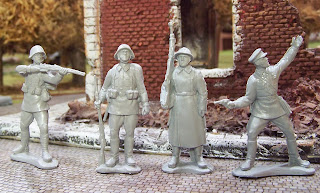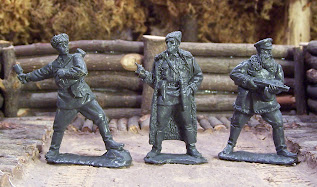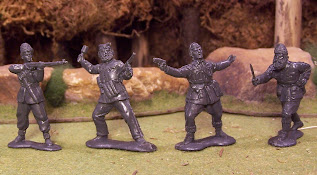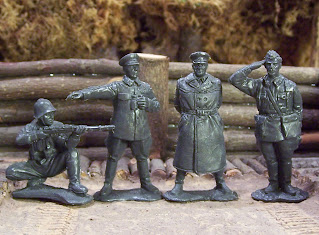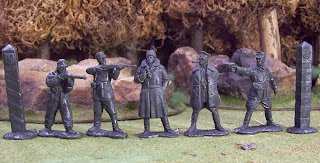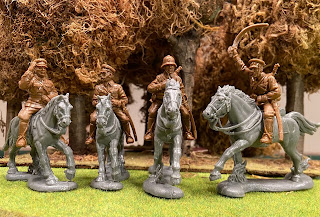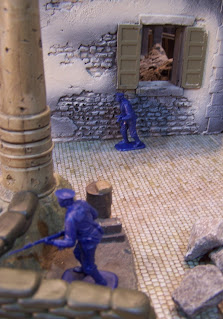Latest edit: Red Army Continued
______________
Engineer Bassevich is a Russian firm that I recently discovered. They also seem to have entered the market not long ago as they only offer 4 sets of figures at this time. All of them are Russian/Soviet figures, 3 from the Russian revolution and one set from WWII as you will see below. I find myself a bit ambivalent about these figures. On the one hand, the poses are nicely done, with a good degree of action and they have a lot of nice detail. For instance, the expressions on the faces of these figures are among the best I've seen. The casting however is not so great. The figures come with a lot of flash. Part of it looks like marks left over in the clay during the sculpting, the rest is probably from the mold. Also, the plastic that they are made of is very light. I tend to like figures better when they have a bit more weight. And then there is the price... not only are they very expensive relative to the average new production toy soldier, but you also end up paying a hefty shipping cost. At the end of the day each of them comes to about 5 dollars a piece, which not even many vintage figures fetch. So are they really worth it? We'll have to see how they paint up.
Engineer Bassevich early war Soviet Infantry - Part I
These are early war Soviet Infantry figures. These are some of the few Soviet figures made with a full backpack. Nice degree of action in this first batch.
Engineer Bassevich early war Soviet Infantry - Part II
I could have done without the two guys standing in the middle, in favor of two more action poses. BTW, notice the diversity in the uniforms and headgear at this early stage of the war. The officer leading his men reminds me of an actual WWII photograph that I've seen. Take a look at the next picture.
If it were printed backwards and the officer had the pistol on the opposite hand, it would be quite a close match...
Engineer Bassevich Soviet Partisans - Part I
A unique set by Engineer Bassevich. The depiction of these partisans strikes a nice balance between showing them as civilians and soldiers. For example, the guys above might have just joined the partisan unit and are still wearing some of their original clothes and their weaponry is lacking automatic firing.
UPDATE: I had the good fortune of getting some input from Alex, the man behind Engineer Bassevich's figures and he supplied me with a description for some of the figures. For instance, these guys could be used as members of the factory workers Fighter Battalion at Stalingrad during the summer of 1942. If you take out the guy throwing the grenade, who is holding the automatic weapon, they could also be used as members of the People's Militia Division, during the summer of 1941. Automatic weapons were not available outside of the professional army during the earlier part of the war.
Engineer Bassevich Soviet Partisans - Part II
These guys however are more rugged and is likely that they are regular army troops who got left behind the enemy lines and joined the partisans, giving them some badly needed training and leadership. As far as the quality of the figures go, I am quite pleased with this set. They don't have any flashing, and the plastic used to make them feels more dense, making them feel a bit more robust. The level of detail in the sculpting as you can see, is really great.
UPDATE: Thanks to Engineer Bassevich we now know a bit more about the source of inspiration for these figures. The man in the middle is the legendary Sydir Kovpak, leader of the partisan units in the greater Ukraine-Belarus area -see picture below-. He was officially recognized by the Soviet military command and awarded the rank of Major General. The man on the right represents Pyotr Vershigora, who was Kovpak's second in command and eventually also rose to the rank of Major General.
Here is a picture of Major General Sydir Kovpak, partisan leader in the greater Ukraine-Belarus area
Engineer Bassevich Soviet Partisans - Part III
These guys are probably a mix of civilians and ex-soldiers, but have been in the Partisan ranks long enough to have more sophisticated clothes and equipment. A very interesting touch is the kid in the middle, holding a captured German sub-machine gun. I actually saw a picture of such a kid, dressed very much the same way, which was surely the inspiration for the pose.
UPDATE from Engineer Bassevich: The guy on the right, would have belonged to the division of the People's Militia. Maybe a former teacher. He can be used in the Battle of Moscow, along with soldiers from set number 1. The man on the left could have been a regular army officer left behind the enemy lines after his unit was encircled and then he joined the partisans.
Engineer Bassevich Yugoslav Partisans - Part I
Another set of partisans. These are supposed to be Tito's partisans from Yugoslavia, but I think they could pass as partisans from any occupied country. Note that many of them feature long beards though, so if you are strict about cultural matters, maybe that restricts your options. I am actually planning to mix them with the Soviet partisans and have a larger unit of unregulated militia guys.
Engineer Bassevich Yugoslav Partisans - Part II
One thing I like about this set from Engineer Bassevich is that most of the poses are fighting poses and we got a lot fewer guys standing around.
Engineer Bassevich Yugoslav Partisans - Part III
I am OK with a commander standing around, observing the action. The only guy I don't really have much use for is the 'guard' next to the commanding officer.
Engineer Bassevich Soviet Infantry - Part I
This set is theoretically an Infantry set, but it is actually a mix of several service branches. The guys in this picture for instance represent a couple of high-ranking officers, and two regular army guys. The officer with the big coat must be some kind of big shot who is probably standing way behind the front lines.
UPDATE: Added description based on input from Engineer Bassevich. From left to right:
-Ninth soldier in set number four. Just infantry.
-The officer in his uniform is Tymoshenko - Marshal of the USSR People's Commissar of Defense, subsequently commander of the Western Front (Smolensk), and then the South-Western Front (Kiev) in 1941.
-The officer in a field coat is Zhukov - General of the Army, Chief of the General Staff between February - July 1941.
-Officer wearing a soldier's garrison cap. The officers realized that snipers hunt officers. I think this is a Lieutenant. First lieutenants would gets out of the trench and lead soldiers to attack. Lieutenants were killed in large numbers.
Engineer Bassevich Soviet Infantry - Part II
These other guys are the crew of a tank and the guy on the right looks like a downed airman firing off a signal gun, perhaps hoping to be rescued before the enemy gets to him. Certainly not the average poses in an infantry set, however they will come handy in some unique scenes, not to mention that the nice level of detail will also make them look quite good when painted.
Input from Engineer Bassevich. From left to right:
-Courier on a motorcycle (motorbike lost, courier shoots a gun, because the courier was attacked by soldiers from the regiment of Brandenburg).
-Soldier tank crew.
-Tank crewman in a leather jacket.
-Pilot in winter uniform. Maybe his plane was shot down. Maybe the pilot signals "in the machine".
Engineer Bassevich Soviet Infantry - Part III
The last three poses in the set represent an artillery crew. Here I am showing them manning the Italeri ZiS 3 76mm Anti-Tank Gun, however that gun comes with its own crew, so now I am thinking that perhaps I will use them to man a captured German PAK of which I have several who are still lacking a crew.
Input from Engineer Bassevich -with minor edits:
Three gunners in officer caps. Officer caps were worn among ordinary soldiers in the border troops and cavalry. Here obviously the border troops. The ZIS-3 Italeri is not appropriate for 1941. Can use PAK36 FOV, similar to Russian 45mm anti-tank gun. However, I think the shells belong to a 122-mm howitzer. For that you can also use WWI British guns (Crescent, Britains). In 1941, the Red Army used a lot of old weapons, including old helmets (analogue French Adrian).
Related picture supplied by Engineer Bassevich.
Engineer Bassevich Finnish Infantry - Part I
This is another nice set from Engineer Bassevich, which understandably has chosen to cover this theater. It contains a total of 10 Finn soldiers, although only 6 of them represent fighting poses. As usual with Bassevich's figures, they are well sculpted with a very nice level of detail. They also represent a good level of diversity on the uniforms being worn, however this might pose some challenges if you are trying to build up a sizeable unit of similarly clad men.
Engineer Bassevich Finnish Infantry - Part II
Of these, my favorite one is the man on the left, standing while firing the sub MG. He is wearing white cammo overalls and a German style helmet. Definitely a great fit for the Winter War scene once he is painted all in white. The officers in the middle are probably some known historic characters, as is the case in some of the other Bassevich sets, but I must say that I would have rather had a couple more action poses than this many officers.
Engineer Bassevich Soviet Infantry - Winter War
Not to leave the Finns without an opponent, this set also contains four Soviet soldiers, although that's hardly going to be enough to mount an offensive. Note also that the set contains two 'border' posts. One has the emblem of the USSR and the other the one from Finland. Again, a nice touch, but I would have preferred to have two more men if I had a choice. Also, if there are going to be only 4 men, why make two of them just stand around? One nice touch is the head gear on the figures. Two of them are wearing the pointed winter caps (I thought they were used by cavalry units) instead of helmets.
Engineer Bassevich Soviet Military Women - Part I
Another unique set from Engineer Bassevich. This time the set is a bit of a mix. 8 Figures represent women across a range of military roles. As with some of the previous sets, some of the figures are inspired by actual historical characters. In this first picture we have Marina Raskova (far right), a pioneer in the Soviet Air Force and founder of 3 female pilot regiments. The next character is supposed to be a brave girl who rushed under the tank with and blew it up using a pack of grenades. This happened in September 23, 1943 near the village of Ivanenko, Ukraine. The sniper figure is supposed to honor women such as Lyudmila Pavlichenko, Rosa Shanina, Elizabeth Mironova, Mary Polivanova, Natalia Kovshova. Below are a few pictures which inspired these figures sent to me by Alex, the man behind Engineer Bassevich.
Elizabeth Mironova and the movie character which inspired the figure with the sub MG
Grenade Girl and Marina Raskova
Engineer Bassevich Soviet Military Women - Part II
On this picture we have Zina Tusnolobova, who lost all limbs helping the wounded in combat. While on the hospital, a tank unit heard of her and named 5 tanks after her. Another famous medic was Valeria Gnarovskaya (far right), a medic credited with saving many lives. In a single battle she is said to have brought from the battlefield 47 wounded, and then went on to defend them, killing over 20 and enemy soldiers. The figure in the left is a road inspector, as were Sonya Petkovska and Marya Shalneva. Below are a few more pictures which inspired these figures sent to me by Alex, the man behind Engineer Bassevich.
Marya Shalneva and women at attention
Medical instructor Valeria Gnarovskaya and medic Zina Tusnolobova
Zina Tusnolobova caring for a wounded man and one of the tanks named after her
Engineer Bassevich Soviet Scouts
These other 4 figures represent Red Army scouts. I like the 3 figures on the left better than the man on the right. He reminds me of the old days sculpting which would favor flat figures for ease of casting and release. I wonder why they made him this way. In terms of uniforms, the head cover and thickness strongly suggests that these are winter troops, although I suppose you could also paint them in a cammo scheme. Notice how they are also equipped with sub machine guns, suggesting that they were used as an elite, shock unit.
Engineer Bassevich Soviet Infantry - Battle of Berlin Part I
Another nice set from Engineer Bassevich to commemorate the 75th anniversary of the capture of Berlin. A set with a nice level of detail and a generous number of poses (12!). Notable among them is the figure representing the man who raised the Soviet flag over the Reichstag. The figures are well proportioned, although a bit bulkier than those from other manufacturers, and the poses show a nice level of action, and are adequate for urban fighting. Speaking of comparisons with other manufacturers, I do like Engineer Bassevich's plastic better. It is harder and therefore the tips of weapons do not get bent.
Engineer Bassevich Soviet Infantry - Battle of Berlin Part II
The other poses also represent some of the other service branches, with a couple of tank men fighting outside their vehicles and what appears to be an airman fighting on the ground with his side arm. Another thing I like about this set is that there are no figures standing guard as in many of EB's prior sets. Again, the level of detail on the figures is really good, and the manufacturing process did not leave any flashing. A very nice set, worthy of the event it commemorates.
Engineer Bassevich Soviet Cavalry
Finally a Soviet Cavalry set. Unfortunately, we only got 4 figures. Three of them seem to be on the march or on parade. One of them is charging at some imaginary enemy. The level of detail on the figures is nice and the sculpting and detailing is good. For example, the medals on the officers gives them a very nice touch, and I also like the mustaches on them. My main criticism about this set is that the choice of poses doesn't really allow to create a real fighting force. It almost feels like it might have been better to not have the charging man and at least have another man riding in formation. In terms of the horses, they come in two varieties. The two larger horses are galloping. The other two are shorter and trotting. Going back to the poses, I think one galloping horse would have been adequate for the charging man. The other three riders just needed the trotting horse. The second galloping horse ended up getting a rider who seems too relaxed for the situation. Anyhow, It's good to finally have some representation for these figures. Hopefully we'll get some more sets / poses in the future, but I am not very optimistic about that.
Engineer Bassevich Soviet Field Hospital - Part I
This set is addressing a range of characters that you might have run into within a dressing station or a hospital close to the front. Two key figures here are the surgeon and the nurse in their operating gowns. Then you have the stretcher bearers who would do the hard work of bringing their wounded comrades if they lived long enough to get there. These figures are well done. The only unusual thing is that the man carrying the front of the stretcher seems to have a very flat face, without a nose.
Engineer Bassevich Soviet Field Hospital - Part II
Here we have a couple of characters who would have been at the front. Maybe a wounded pilot who crash landed, and a couple of medics supported by a dog trying to reach him to lend him aid. There's also a couple figures who would have been at the field hospital recovering from their wounds, and perhaps trying to make life a little livelier. And then we also have this other figure documenting the scene -the horrors of the wounded, and the high spirits of the man around camp- probably for some propaganda film. All of them interesting and unique characters addressing a topic not covered often. I typically prefer frontline figures, but with the wealth of Soviet infantry figures already made, it seems reasonable to branch out and cover these other subjects.
Engineer Bassevich Soviet Red Army Continued - Part I
This set came with ten figures. The first five pictured above are a bit unremarkable. Three of them are just standing around. One of them is firing from a standing position - we have many of those, and the other one is advancing or standing pointing his bayonet forward. Maybe their best feature is that they are dressed in winter long coats. So why did I buy this set then? Well take a look below...
Engineer Bassevich Soviet Red Army Continued - Part II
It was these five guys which convinced me to get this set. As you may already know by now, I have a soft spot for Soviet Naval Infantry, and these five sailors are definitely more interesting and dynamic than the previous five figures - at least they are engaged in battle! They are not the best naval infantry figures in my collection in terms of poses and sculpting detail, but they will add a bit more guys and variety to the unit. Maybe the most interesting guy is the one going cowboy, who also got rid of his jacket along the way - and will look nice when his striped shirt is properly painted. I also like the man throwing the grenade and how he has loaded himself with extra ammo belts as did a couple more of his fellow sailors. All in all a good second half of the set.
Click here to see a post about Soviet Infantry
Click here to see a post about more Soviet Infantry
Click here to see a post about Soviet Naval Infantry
Click here to see a post about Soviet Armor
Click here to see a post about Soviet Infantry in action

